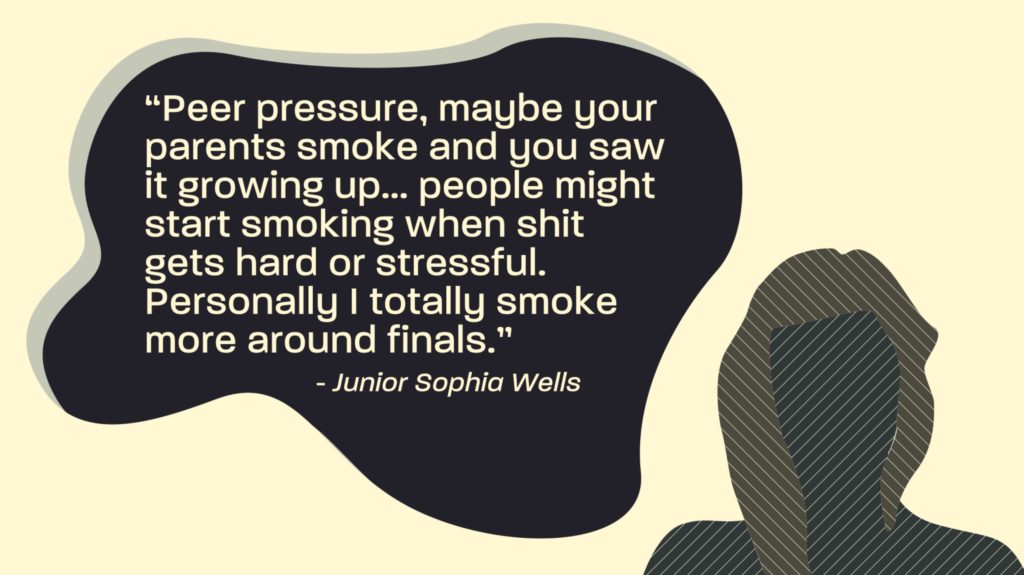Junior Lauren Kelly likes to take a smoke break during times of stress. As a film, photography, and visual arts major, Kelly said, she mostly smokes on sets as a stress relief and a social activity. She said she and about 10 of her friends tend to hang out and smoke together for the shared experience.
“If I’m hanging out with friends and they’re smoking, I’m going to smoke,” she said. “I feel like a lot of people get into smoking because it’s a social thing. You want to fit in, and you want to hang out with people, and if they’re smoking, you want to smoke.”
Meanwhile, anti-tobacco campaigns like “Truth” commercials are encouraging the millennial generation to “Be the generation that ends smoking.” Truth commercials typically feature electronic music and try to influence young adults not to smoke with ads like “left swipe dat,” where people who are smoking in their dating site profile pictures are rejected.
There are 1,713 smoke-free campuses across the United States as of Oct. 1, including SUNY Cortland, according to No-Smoke.org. Ithaca College may soon join the growing list of colleges around the nation that have decided to go smoke-free.
During the spring semester, Tim Conners, Student Governance Council senator for the Class of 2017, proposed a Tobacco Free IC bill, which would create a committee that would eventually write a policy banning the use of tobacco on the college’s campus. The bill passed through the SGC by a 6–2 vote. Conners said he hopes the policy will be in effect by Fall 2017.
Currently, smoking is only allowed in designated smoking areas on campus, such as the Academic Quad, the Textor Patio and the F-Lot parking median. These spaces are listed in the Ithaca College Policy Manual, which can be found online. Smoking is banned in all indoor environments with the exception of when it is necessary during theatrical performances, and smoking is prohibited within 20 feet of the entrance or exit of any building. Conners said the school should push to be smoke-free to create a friendlier environment.
“I can be around people that smoke, but I prefer not to in a home environment like a dorm,” Conners said. “As I was talking with people more and more about it, they said, ‘Yeah, I hate walking out of this building and all you smell is smoke.’ It wasn’t just something I was concerned about. People were also sharing their problems.”
During the spring semester, seniors Alex Horner and Sethavatey Limsreng, along with Aniebietabasi Ekong ’16, designed a device called StopPack to help smokers quit in a chemical-free way. The StopPack is a case that holds a pack of cigarettes and records the number of times the user reaches for a cigarette in the corresponding smartphone app, which is still in development.
Limsreng said the app will have three different features: a tracking feature that tracks factors contributing to addiction such as how often a person smokes, where a person smokes, money spent and time spent; a section for goal-setting, where users can set personal goals for how much they would like to smoke for a certain length of time; and a feature sponsored by Alcoholics Anonymous in which users can handpick their own support buddy, who will keep track of their progress.
The idea originated as a project for management instructor Brad Treat’s course, Ideas into Action. Limsreng said that over the summer, the group was selected into the Rev Hardware Accelerator Program in downtown Ithaca, where it built the hardware for the prototype.
“I study relapse rate and whether those chemical methods work, and there is a 90 percent relapse rate,” she said. “So you would use e-cigarettes, but then after a year, you would relapse. The idea behind this app is that addictions should be cut down bit by bit and not forced into it. The important part is to do it with support and love.”
According to the Centers for Disease Control and Prevention, 36.4 percent of high school students identified as smokers in 1997, which then dropped to 23 percent in 2005. Currently, the proportion of smokers among high school students is at a record-low 9.3 percent. This translates into a decrease in the number of students who smoke in college. About 25.9 percent of students smoked in college in 2000, while only 14 percent of students currently smoke in college, according to the American College Health Association.
Conners, a cancer survivor, was left blind as a result of cancer reaching his optic nerves. Conners has an interest in working with students with disabilities, who, he said, are especially affected by cigarette smoking because they can only get into buildings through particular entrances and routes. This means that if smokers are crowded outside one of these entrances, it is unavoidable for students who have to travel that way.
Conners said people with service animals can be affected as well because the animals may sniff out or ingest cigarette butts, which is dangerous to their health.
“The rule is that you have to be so far away from the building, but the smoking depositories are right outside the building, so the message is blurred,” Conners said.
Conners worked with Ted Schiele, tobacco control program coordinator from the Tompkins County Health Department, to draft the bill, which was rejected at first, reworked by Conners with help from Schiele, and then passed on May 2.
“In a lot of ways, we wanted to keep people in mind with this,” Conners said. “We want to create a path that does not victimize and does not undercut people. Addictions are serious things, so we want to be able to set people up with resources.”
Schiele has worked with the Tompkins County Health Department’s Health Promotion Program for about 16 years and is responsible for developing the T-Free zone signs that can be seen around Tompkins County. He said the Bureau of Tobacco Control’s overall goal is to reduce tobacco use among youth, reduce exposure to secondhand smoke and support current smokers who want to quit.
“The thing that we’ve been most successful with so far over the years is reduced exposure to secondhand smoke,” Schiele said.
Schiele said Tobacco Free Tompkins, a program that was launched by the county health department, began implementing T-Free zones about 10 years ago. As part of the program, the health department asked business owners to not allow people to smoke outside their doors. Schiele said he spoke with members of the Ithaca Common Council in 2007 about having The Commons become a smoke-free zone, which would eventually become a city ordinance in 2010. Schiele and Conners stressed the idea that smoke-free is not a new concept to the area.
“The presentation is that we are not discriminating against people,” Schiele said. “We are supporting people who prefer to be in a smoke-free situation. The first thing to do is to talk to people who feel hassled by the smoke-free zones and make a connection with them to let them know they’re not the villain.”
According to a web-based survey conducted by the Center for Health Promotion in the Office of Counseling and Wellness in 2015, 11 percent of students at Ithaca College identify as smokers. This is consistent with a survey conducted by The Ithacan in September, which found that 10.3 percent of the 174 students who took the survey identified as smokers. More than half of the respondents to this survey, 51.7 percent, said they believe smoking should be banned on campus, and as many as 130 students gave written responses with their reasons for believing that smoking should be banned.
“I think that smoking on campus is not good for the overall appearance of IC,” one student wrote. “People leave their cigarettes around everywhere, and the smell is terrible.”
“I hate the smell of smoke,” another student wrote. “It’s really irritating to my lungs, so I don’t think we should have smoking on campus because people don’t follow the designated areas anyway.”
Kelly said she thinks people are generally more accepting of smoking on the college’s campus than on other campuses because it is a liberal arts school. However, she said she still takes into consideration those who don’t like the smell of cigarettes and tries to avoid smoking in crowded areas or bothering people with her cigarette smoke.
In response to the possible cigarette ban on campus, Kelly said she understands the motive of better student health and not submitting others to secondhand smoke, but feels people should be free to choose what they do with their bodies. She said the school should have increased signage for designated smoking areas instead.
“I feel like if [the smoking stations] are something that people are aware of, they will use it, but I don’t think people know where a lot of the smoking areas on campus are,” Kelly said.
Junior Sophia Wells also said she smokes for stress-related reasons in addition to using it for social activity.
“Peer pressure. Maybe your parents smoke and you saw it growing up, going through like problems and stuff — people might start smoking when shit gets hard or stressful,” Wells said. “Personally, I totally smoke more around finals.”
Bonnie Prunty, director of residential life and judicial affairs and assistant dean for First-Year Experiences, said there isn’t a problem with students’ smoking inside or too close to residence halls.
“If students are smoking outside the building closer than they’re supposed to, staff may ask them to move, but so could a random student or faculty member,” she said.
Prunty said for students and faculty who live and work at the college, a solution should be reached that can benefit both smokers and non-smokers.
“I’m not a smoker, but if I was right now, I could at least step out far away from the building and smoke,” she said. “If I was on a smoke-free campus, would I have to get in my car and drive off campus on my cigarette break?”
Changhee Chun, associate professor of media arts, sciences and studies, said that while he enjoys smoking on campus, he would comply with any changes in policy.
“If I can smoke occasionally on campus, that works for me, but if the majority support [a smoke-free campus], I would follow it,” he said. “Whatever the community decides is fine with me.”
However, Alexander Moon, assistant professor in the Department of Politics, said he would be fine with a ban because of a desire to quit himself but feels it may be heavy-handed.
“It seems incredibly paternalistic. I’m not sure why SGA has that right,” Moon said. “Maybe we should ban soda and potato chips, too.”
Wells said rules and regulations banning smoking may not be effective because students will do it anyway.
“People can try banning things,” she said. “I totally get the reason why a tobacco-free campus would be preferable, but you can’t really ban alcohol or weed or, now, tobacco. People will do it anyway. In general, people who smoke don’t like that they smoke. It’s not something they’re proud of.”
While a smoke-free campus could be difficult for current smokers to adapt to, Schiele said, the ultimate goal is to get smoking out of the social consciousness.
“It fits well into the young-adult concept of being different and trying out new things and fitting in with different social groups, but being addicted to nicotine is not healthy and it’s not fun,” Schiele said.









